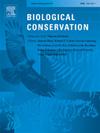Spatial distribution of tree-related microhabitats in European beech-dominated forests
IF 4.9
1区 环境科学与生态学
Q1 BIODIVERSITY CONSERVATION
引用次数: 0
Abstract
Tree-related Microhabitats (TreMs) are of prime concern for biodiversity since they host thousands of taxa. TreMs are discrete habitat patches borne by trees and cover a wide range of lifespans, from days to decades to centuries. The taxa associated with such discrete and sometimes highly ephemeral habitat patches are likely to be sensitive to spatial distribution because they need to search for new habitats after the occupied one disappears. Although many studies have recently been dedicated to TreMs, only very few have investigated their spatial distribution. Focusing on European beech-dominated forests, we used a European TreM database with 12,362 trees and 296 plots (ranging from local (0.1–1 ha) to landscape scale (10,000 ha)) to assess TreM spatial distribution patterns in long unmanaged forests. Then, with a TreM sub-database with 6828 trees and 21 plots, we assessed whether and if so, how harvesting changes spatial patterns at the plot scale. In long unmanaged forests, most TreMs showed a regular pattern at the plot scale and an aggregated pattern at larger scales. Tree diameter was the most influential factor for spatial patterns in TreMs. Spatial patterns at the plot scale in harvested forests differed slightly from those observed in unmanaged forests. To favor TreM-dwelling taxa in harvested stands, our results suggest retaining habitat trees in a regular spatial pattern to mimic the natural pattern. However, some TreMs should be conserved in an aggregate pattern; we specify the spatial scale at which this should be done.
欧洲以山毛榉为主的森林中与树木有关的微生境的空间分布
与树木相关的微生境(TreMs)是生物多样性的首要关注点,因为它们承载着数以千计的类群。树木相关微生境是由树木形成的离散栖息地斑块,其寿命范围很广,从几天、几十年到几百年不等。与这种离散且有时极短暂的栖息地斑块相关的分类群很可能对空间分布很敏感,因为它们需要在被占据的栖息地消失后寻找新的栖息地。虽然最近有很多研究都是针对树瘤的,但只有极少数研究调查了树瘤的空间分布。我们以欧洲以山毛榉为主的森林为研究对象,利用一个包含 12,362 棵树和 296 个地块(从局部(0.1-1 公顷)到景观尺度(10,000 公顷))的欧洲树瘤数据库,评估了树瘤在长期无人管理的森林中的空间分布模式。然后,我们利用包含 6828 棵树木和 21 个地块的树木监测子数据库,评估了采伐是否会改变地块尺度上的空间分布模式,如果会,又是如何改变的。在长期无人管理的森林中,大多数树冠变化在地块尺度上呈现规则模式,而在更大尺度上呈现聚集模式。树木直径是影响树木分类群空间格局的最大因素。 在采伐森林中,地块尺度上的空间格局与在非经营性森林中观察到的略有不同。我们的研究结果表明,为了使采伐林分中的树木群落更有利于树木群落的栖息,应按一定的空间模式保留栖息地树木,以模仿自然模式。然而,有些树木应该以集合的模式保留;我们明确了应该在何种空间尺度上这样做。
本文章由计算机程序翻译,如有差异,请以英文原文为准。
求助全文
约1分钟内获得全文
求助全文
来源期刊

Biological Conservation
环境科学-环境科学
CiteScore
10.20
自引率
3.40%
发文量
295
审稿时长
61 days
期刊介绍:
Biological Conservation is an international leading journal in the discipline of conservation biology. The journal publishes articles spanning a diverse range of fields that contribute to the biological, sociological, and economic dimensions of conservation and natural resource management. The primary aim of Biological Conservation is the publication of high-quality papers that advance the science and practice of conservation, or which demonstrate the application of conservation principles for natural resource management and policy. Therefore it will be of interest to a broad international readership.
 求助内容:
求助内容: 应助结果提醒方式:
应助结果提醒方式:


